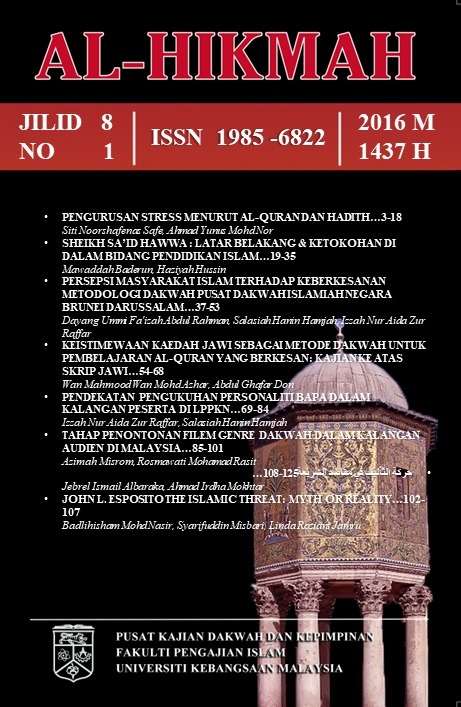STRESS MANAGEMENT ACCORDING TO THE QURAN AND HADITH
Pengurusan Stress Menurut Al-Quran dan Hadith
Abstract
Stress is a phenomenon that has a strong influence on human life. Each individual will not be spared from suffering stress because it is strongly associated with lifestyle, a person's character, family factors, urbanization and modernization of culture shock of sudden growth. Stress is a response to the physical, emotional and mental to any changes or demands. Stress can happen to anyone irrespective of age, gender, race or religion. Medium stress can motivate someone’s life development, yet excessive stress is undermining. The study was conducted as one of the issues related to the Quran and Hadith. Qualitative research methods based on previous studies and analysis premier sources such as Qur’ān and Hadith have been used for information analysis. In addition, the findings also identified a number of relevantstress managements that can be used by Muslims in particular and others in general.
References
A, Caspi et. al. 2003. Influence of Life Stres on Depression: Moderation by a Polymorphism in the 5-HTT Gene. Journal of Science. DOI: 10.1126/science.1083968
Chaplin, J. P. (2000). Kamus Lengkap Psikologi. Dr. Kartini Kartono (terj.). Jakarta: PT Raja Grafindo Persada.
C. Mimura & P. Griffiths 2003 The effectiveness of current approaches to workplace stres management in the nursing profession: an evidence based literature review. Journal of Occupational and Environmental Medicine.
Danial Zainal Abidin. (2009). Quran Saintifik Meneroka Kecemerlangan Quran daripada Teropong Sains. Kuala Lumpur: PTS Millennia Sdn Bhd.
D. Steven & K. Brian. 1994. Effective Stress Management. Occasional paper (Royal College of General Practitioners). Managerial Auditing Journal. Vol. 9 No. 6, pp. 31-34
European Agency for Safety and Health at Work. (2000). Research on Work-related Stress. Diakses pada 19 Ogos 2011 daripada http://osha.europa.eu/en/publications/ reports/203.
Harussani Zakaria. 2004. Khidmat Nasihat dalam Islam. Artikel.
Hatta Sidi. 2002. Mengurus Stres: Pendekatan yang Praktikal. Kuala Lumpur: Dewan
Bahasa dan Pustaka.
Hatta Sidi. 2012. Keresan: Penyakit & Rawatan. Bangi: Penerbit Universiti Kebangsaan Malaysia.
Ivancevich, J. M., Matteson, M. T., Freedman, S. M., & Phillips, J. S. (1990). Worksite stress management interventions. American Psychologist, 45, 252–261.
Md. Taib Dora & Hamdan Abd Kadir. 2006. Mengurus Stres. Batu Caves: PTS Professional Publishing.
Mohd Razali Salleh. 2010. Pengendalian Stres dan Kebimbangan: Penilaian Kognitif dan Tingkah Laku. Pulau Pinang: Penerbit Universiti Sains Malaysia
Muhammad Rashidi Wahaba & Mohd Faizul Azmia. 2013. Kedudukan Akal dalam Pendalilan Akidah. Jurnal Teknologi (Social Sciences) 63:1 (2013), 31–39.
Nor Azah Abdul Aziz. 2011. Kaedah Menangani Stres dengan Solat. Journal of Islamic and Arabic Education. 3(2), 2011 1-10. Universiti Pendidikan Sultan Idris
Shiqah Jantan. 2010. Tahap Stres dan Tahap Kepuasan Kerja dalam Kalangan Pensyarah Universiti Teknologi Malaysia. Tesis Sarjana Universiti Teknologi Malaysia.
Sapora Sipon. 2010. Pengurusan Stres. Sekolah Psikologi dan Kerja Sosial, Universiti Malaysia Sabah. Kertas kerja seminar kursus pengurusan stres di Maktab Sabah.
Sayyid Muhammad Alwi. 2010. Keistimewaan-keistimewaan al-Qur’ān . Kuala Lumpur: Alam Raya Enterprise.
Steven B. Donovan & Brian H. Kleiner. 1994. Effective Stress Management. Managerial Auditing Journal. Vol. 9 No. 6, 1994, pp. 31-34
Thomas J. Connor & Brian E. Leonard. 1998. Depression, Stress and Immunological Activation: The Role Of Cytokines In Depressive Disorders. Life Sciences. Vol. 62, No. 7, pp. 583-606.
VandenBos, G. R. (2007). APA Dictionary of Psychology. Washington: American Psychological Association.
© 2025 Al-Hikmah.
Copyright of the published article is vested in UKM Press, Universiti Kebangsaan Malaysia upon formal acceptance and completion of the copyright transfer agreement.
All articles are licensed under a Creative Commons Attribution–NonCommercial 4.0 International License (CC BY-NC 4.0), which permits non-commercial use, distribution and reproduction in any medium, provided the original work is properly cited.





